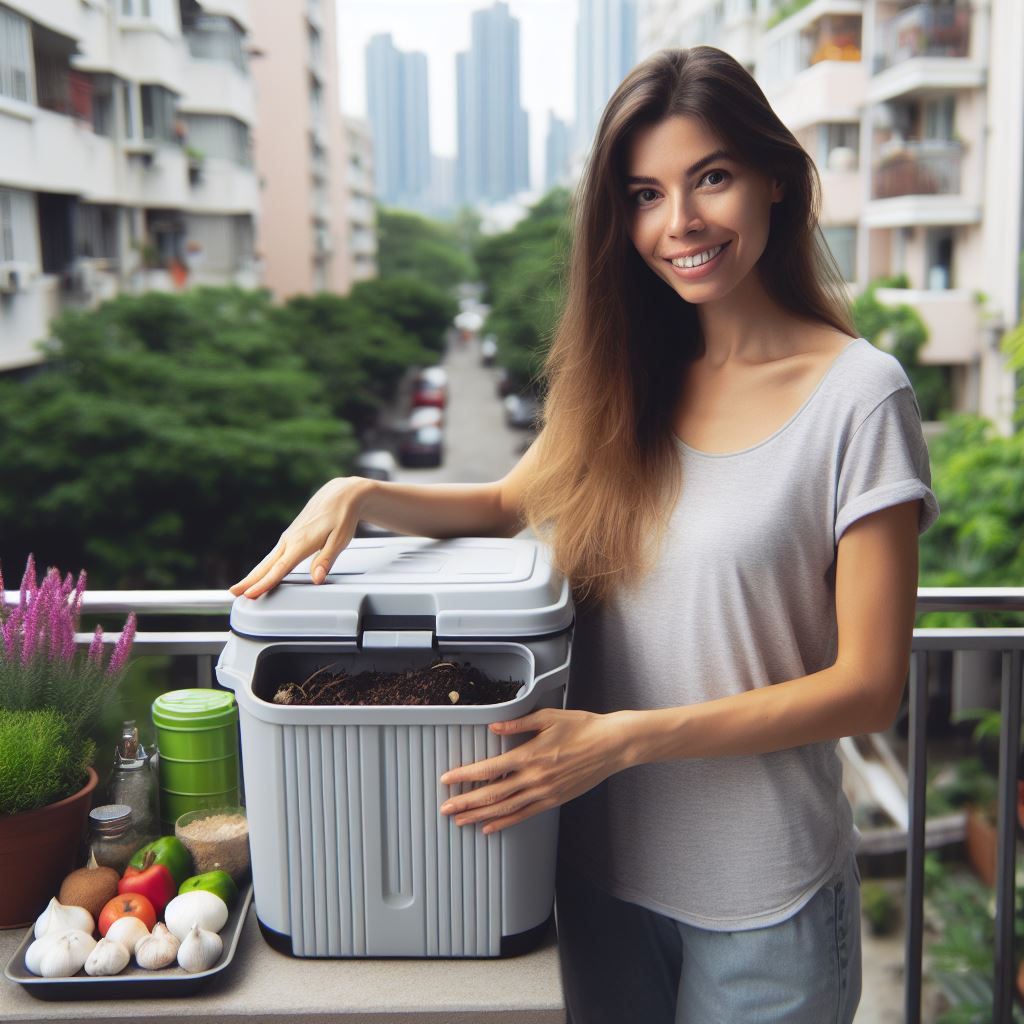Introduction
Explanation of compact composting
Discover effective waste reduction in urban areas with Compact Composting Urban Eco Tips, a specialized method tailored for city living.
It involves using small containers or bins to compost organic waste in a limited space.
Importance of composting in urban areas
Composting in urban areas is important because it helps reduce the amount of waste that goes to landfills and contributes to greenhouse gas emissions.
It also promotes sustainable living practices and helps improve soil health.
Overview of the benefits of compact composting
The benefits of compact composting are numerous.
It enables urban dwellers to recycle their organic waste and turn it into nutrient-rich compost that can be used for gardening or landscaping purposes.
Compact composting also reduces the need for conventional fertilizer and saves money.
Additionally, compact composting helps to conserve water by improving soil moisture retention and reducing irrigation needs.
It also reduces the demand for chemical pesticides by promoting healthy soil ecosystems that naturally suppress pests and diseases.
Furthermore, compact composting can foster a sense of community and engagement among urban residents.
Composting can be done on an individual level or in community gardens, allowing people to connect with their neighbors and work together towards a common goal of sustainability.
Basically, compact composting offers a practical solution for urban dwellers to manage their organic waste and contribute to a more sustainable and eco-friendly lifestyle.
By composting, individuals can help reduce waste, improve soil health, conserve water, and build stronger communities.
Types of Compact Composting Methods
Now that we’ve covered the benefits and basics of compact composting, let’s dive deeper into the different methods available.
In this section, we will explore three popular compact composting methods: worm composting, bokashi composting, and tumbler composting.
Transform Your Agribusiness
Unlock your farm's potential with expert advice tailored to your needs. Get actionable steps that drive real results.
Get StartedWorm Composting
Worm composting, also known as vermiculture, utilizes worms to break down organic waste into nutrient-rich compost.
It’s an effective method for those with limited space or living in urban areas.
To set up a worm composting system, you’ll need a container with proper ventilation, such as a plastic bin with small holes.
Line the bottom with newspaper or cardboard to prevent leakage.
Add bedding material like shredded paper or leaves, and moisten it slightly.
Introduce the worms to the bin along with your organic waste.
Red worms and tiger worms are commonly used for composting.
They consume the waste, converting it into rich compost.
Remember to avoid adding meat, dairy, oily food, or pet waste to the bin.
To manage and maintain a worm composting bin, ensure proper moisture levels by keeping the bedding damp but not soaking wet.
Regularly add small amounts of kitchen scraps and cover them with bedding.
Avoid overfeeding the worms to prevent odor and fruit fly issues.
Periodically harvest the finished vermicompost by moving the contents to one side of the bin and filling the other side with fresh bedding and food scraps.
The worms will migrate to the new side, allowing you to collect the compost.
Bokashi Composting
Bokashi composting is an anaerobic fermentation process that utilizes beneficial microbes to break down organic waste.
This method is suitable for composting a wide range of materials, including meat, dairy, and cooked food scraps.
To set up a bokashi composting system, you’ll need an airtight container with a drainage system and a bokashi bran, which contains beneficial microbes.
Place a layer of food waste in the container, sprinkle bokashi bran to add microbes, and repeat the layering process.
Press down the waste layers to remove excess air and drain any liquid that accumulates in the container.
Seal the lid tightly to maintain an anaerobic environment.
Allow the waste to ferment for approximately two weeks, periodically draining any excess liquid.
Once the fermentation process is complete, bury the fermented waste in a garden bed or mix it into a traditional compost pile.
The breakdown will continue, and the final product will enrich the soil with vital nutrients.
When using bokashi composting, it’s essential to ensure airtight conditions and proper drainage.
Showcase Your Farming Business
Publish your professional farming services profile on our blog for a one-time fee of $200 and reach a dedicated audience of farmers and agribusiness owners.
Publish Your ProfileAvoid adding large bones or excessive liquids to prevent issues with the fermentation process.
Additionally, periodically clean the drainage system to maintain its functionality.
Tumbler Composting
Tumbler composting is an efficient method that involves rotating a container to mix and aerate the composting materials.
It offers convenience and faster decomposition compared to traditional composting methods.
To tumbler compost, you’ll need a specialized container with a rotating mechanism.
Add a balanced mix of green and brown materials, similar to traditional composting.
The container’s rotation facilitates oxygen flow, enhancing the decomposition process.
One advantage of using a tumbler composting system is that it minimizes odors and keeps pests away.
However, it requires regular turning of the container to ensure proper aeration.
Monitor the moisture levels and adjust if necessary to maintain optimal conditions.
In terms of pros and cons, tumbler composting provides quicker results and is more convenient to manage compared to other methods.
However, it may have a limited capacity based on the size of the tumbler, and some models can be expensive.
To achieve successful tumbler composting, follow the manufacturer’s instructions for usage and maintenance.
Turn the tumbler regularly to provide adequate aeration, and monitor the internal temperature to ensure proper decomposition.
Generally, worm composting, bokashi composting, and tumbler composting are three effective compact composting methods suitable for urban environments.
Each method has its own unique benefits and considerations, so choose the one that best fits your needs and constraints.
With these options, anyone can contribute to sustainable waste management and create nutrient-rich compost for their gardens.
Read: Rooftop Gardens: Sky-High Greenery
Choosing the Right Compact Composting Method for Urban Living
Choosing the right compact composting method for urban living is crucial in maximizing limited space and ensuring successful composting.
In this section, we will discuss important considerations such as space limitations, managing odors, and balancing waste input and compost production.
Considering space limitations
When choosing a compact composting method for urban living, it is essential to assess the available indoor and outdoor space.
Urban dwellers often have limited space, so it is crucial to evaluate the size, location, and accessibility before deciding on a composting method.
Factors to consider when choosing a compact composting method
- Size: Determine if the chosen composting system will fit within the available space.
- Location: Consider whether the composting system should be placed indoors or outdoors.
- Accessibility: Ensure that the chosen method allows for easy access and maintenance.
- By carefully assessing these factors, urban residents can select a composting method that suits their space limitations.
Managing odors
Unpleasant smells can be a concern when composting in compact spaces. However, there are effective strategies to prevent odors from becoming an issue.
Tips for preventing unpleasant smells in compact composting systems:
- Proper aeration: Ensure adequate airflow within the composting system to prevent the buildup of odorous gases.
- Carbon-rich materials: Add materials like dry leaves, straw, or shredded paper to balance moisture and reduce odors.
- Avoid meat, dairy, and oily foods: These can lead to strong odors and attract pests.
By following these tips and using appropriate materials, urban composters can minimize or eliminate odors in their compact composting systems.
Read: Urban Farming: Small Plot, Big Yield
Balancing waste input and compost production
For successful composting, it is crucial to maintain a healthy balance between waste input and compost production.
Understanding the capacity and composting rate of different compact composting methods:
- Capacity: Different composting methods have varying capacities for processing organic waste.
- Composting rate: The speed at which compost is produced can differ based on the chosen method.
To ensure a healthy balance:
- Monitor waste input: Keep track of the amount and types of waste added to the composting system.
- Adjust composting habits: If the composting system is overwhelmed with waste, reduce the input or consider upgrading to a larger system.
By understanding the capacity and composting rate of different methods and adjusting composting habits accordingly, urban dwellers can maintain a sustainable and productive composting system.
In a nutshell, choosing the right compact composting method for urban living requires careful consideration of space limitations, managing odors, and balancing waste input and compost production.
By assessing available space, implementing odor management strategies, and maintaining a healthy waste-to-compost ratio, urban composters can successfully compost in limited urban environments.
Read: Balcony Veggie Gardens: Tips and Tricks

Tips for Successful Compact Composting in Urban Areas
Using the right compostable materials
Examples of suitable kitchen scraps and garden waste:
- Fruit and vegetable scraps
- Coffee grounds and filters
- Eggshells
- Grass clippings
- Leaves and small branches
Items to avoid adding to a compact composting system:
- Meat and dairy products
- Oils and fats
- Processed foods
- Large woody materials
- Chemically-treated plants
Maintaining optimal composting conditions
Monitoring temperature and moisture levels:
- Aim for a temperature range of 110-160°F (43-71°C) for efficient decomposition.
- Keep the compost moist, similar to a damp sponge, to facilitate microbial activity.
Tips for proper aeration and turning:
- Regularly mix the compost pile using a pitchfork to introduce oxygen and break up clumps.
- Consider using a compost tumbler to easily turn and aerate the compost materials.
Harvesting and using compost
When and how to harvest compost from compact systems:
- Allow the compost to mature for at least 2-3 months before harvesting.
- Harvest the compost when it is dark brown, crumbly, and has an earthy smell.
- Sift the compost to remove any remaining large particles and create a fine, consistent texture.
Innovative ways to use compost in an urban setting:
- Create balcony or rooftop gardens by mixing compost with potting soil.
- Add compost to indoor potted plants to improve soil fertility and moisture retention.
- Donate excess compost to community gardens or local urban farms.
- Use compost as a natural fertilizer for street trees and public green spaces.
Using the right compostable materials
Composting in urban areas poses unique challenges, but with the right techniques and materials, it can be a successful and rewarding practice.
Showcase Your Farming Business
Publish your professional farming services profile on our blog for a one-time fee of $200 and reach a dedicated audience of farmers and agribusiness owners.
Publish Your ProfileBy using the right compostable materials, such as fruit and vegetable scraps, coffee grounds, and leaves, urban dwellers can help divert organic waste from landfills and create nutrient-rich soil amendments.
It is important to avoid adding meat, dairy products, oils, and large woody materials to compact composting systems, as these can attract pests and slow down the composting process.
Maintaining optimal composting conditions
Maintaining optimal composting conditions is crucial for efficient decomposition.
Regularly monitor temperature and moisture levels to ensure they fall within the recommended ranges.
Introduce oxygen and break up clumps by aerating and turning the compost pile.
This can be done manually with a pitchfork or with the help of a compost tumbler, which simplifies the process.
Harvesting and using compost
When the compost has matured for at least 2-3 months and reached a dark brown, crumbly consistency with an earthy smell, it is ready to be harvested.
The compost can be sifted to remove any remaining large particles, resulting in a fine, consistent texture.
Once harvested, there are numerous innovative ways to use compost in an urban setting.
It can be mixed with potting soil for balcony or rooftop gardens, enhancing plant growth.
Indoor potted plants also benefit from the addition of compost, improving soil fertility and moisture retention.
Excess compost can be donated to community gardens or local urban farms, supporting sustainable food production.
Additionally, compost can serve as a natural fertilizer for street trees and public green spaces, contributing to a greener and healthier urban environment.
Compact composting is an eco-friendly solution for urban areas, providing a sustainable way to manage organic waste and produce high-quality compost.
By following these tips, urban dwellers can successfully implement compact composting systems, turning their kitchen scraps and garden waste into valuable resources.
So, why not start composting today and make a positive impact on the environment right in your own backyard, or even balcony?
Read: City Herbs: Growing Flavor in Tiny Spaces
Conclusion
Turning Urban Waste into Garden Gold Compact composting offers city residents a simple, eco-friendly solution for turning food scraps and yard waste into fertile soil amendments.
Installing a compact bin, tumbler, or worm composter even in a small urban space allows you to recycle organic waste on-site instead of sending it to methane-producing landfills.
Composting also provides free, nutrient-rich fertilizer to nourish urban gardens, houseplants, and potted plants on balconies and patios.
Vermicomposting with worms speeds the process in tight spaces.
Compact composting reduces your carbon footprint, cuts down on plastic bag use, and keeps useful organic matter cycling locally.
As our cities grow more crowded, sustainable urban living means finding green solutions that allow city dwellers to minimize waste, reduce their environmental impact, and improve urban livability.
Compact composting is one easy yet impactful way we can all contribute.
Consider getting started today – your plants and the planet will thank you! Together through small, mindful actions we can nurture thriving, resilient communities.




